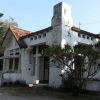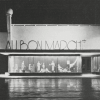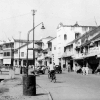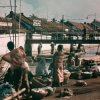
Construction of new houses in the district of New Gondangdia started off very slowly in the first three years. In 1911 16 houses were built, of which 11 on what is now Taman Cut Meutia (formerly Entree Gondangdia and from 1932 onwards Van Heutszplein). In 1912 34 new houses were delivered, in 1913 66. These new houses were built immediately southwest of the train line next to the new building of De Bouwploeg (now Mesjid Cut Meutia) along newly constructed streets like Nieuwe Tamarindelaan (now Jalan Sam Ratulangi), Tandjonglaan (now Jalan Tanjung), Villalaan (now Jalan Cendana) and the prestigious double-lane “Boulevard Gondangdia” which became Van Heutszboulevard in 1924 and Jalan Teuku Umar in 1950.
De Bouwploeg
Most of these streets were not longer than 100-200 metres in 1913, and would then end in sawahs, fish ponds and coconut plantations, as the majority of New Gondangdia and Menteng still characterised at the time. However drilling work could be witnessed at several locations, to prepare the soil for upcoming building works. Construction of the building of De Bouwploeg itself started in April 1912 and was completed in November 1913. This picture dates from 1913 and shows De Bouwploeg in the distance nearing its completion with some bamboo scaffolding left around the dome. The two trams than ran along the middle section of the double road belonged to the line that connected Tanah Abang with Cikini/Kali Pasir.
Palm trees
This new Entree Gondangdia still had a more less countrified appearance in 1913, however the street would soon be lined with majestic palm trees, also known as ‘koningspalm’ in Dutch or ‘palem raja’ in Bahasa Indonesia, and would give the scene a more prominent and stylish character
source: from a postcard in the collection of Leiden University





